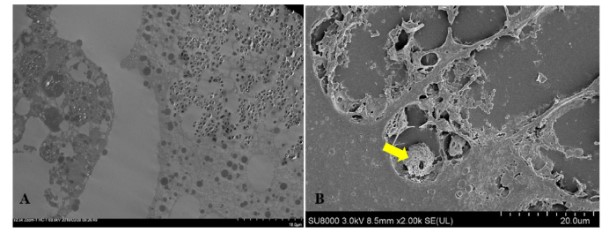
What is Enterococcus?
Enterococcus is a common bacteria found in the intestines of chickens. Sometimes, this bacterium can cause disease when a chicken’s immune system is weakened. Some common species of Enterococcus are E. faecalis, E. faecium, E. cecorum, E. avium and E. hirae. Transmission of Enterococcus can be through contaminated feces.
Enterococcus and Yolk Sac Infections
In the past, Escherichia coli had been primarily responsible for yolk sac infections. In the recent past, Enterococcus has been isolated in cases of yolk sac infections. We do not know how or why this has happened. The goal of our project is to determine the prevalence of Enterococcus in Saskatchewan, where Enterococcus is coming from, and how it causes disease. We will accomplish this by doing breakout analyses of hatch debris, bacteriology of hatch debris and evaluating first week mortality. From the bacteria we isolate, we will fingerprint the isolates to track the exact species and determine where it is coming from. Also, we will be able to tell if the Enterococcus we have isolated is pathogenic (i.e. causes disease) or non-pathogenic.
Our Research
Breakout analysis of hatch debris: We have looked at 3,487 unhatched embryos. The majority of embryo mortality was during the late stages of incubation (34%). Bacteriology of hatch debris: We have found that over 60% of unhatched embryos had bacterial growth. This included embryos with and without visible bacterial contamination. Of the bacteria we isolated, the majority were Enterococcus (35%). Of the Enterococcus species we isolated, the majority (82%) were identified as E. faecalis.
We have recently study the synergism between Enterococcus and E. coli. In a recent study, embryonating chicken eggs were exposed to either Enterococcus, E. coli or both Enterococcus and E. coli. Even though the bacteria were found in the organs of the embryos, there was no negative effects of Enterococcus or E. coli alone. Interestingly, there was high neonatal mortality in birds exposed to both bacteria (Karunarathna, 2022, Poultry Science, 101(8)).
 Electron microscopy of the yolk sac. Enterococcus colonization on the left and biofilm like structure of E. faecalis attaching the yolk sac epithelium (yellow arrow).
Electron microscopy of the yolk sac. Enterococcus colonization on the left and biofilm like structure of E. faecalis attaching the yolk sac epithelium (yellow arrow).
(Karunarathna, 2022, Poultry Science, 101(8))

